
One season into their existence, the Montreal Canadiens franchise as it was known and owned, temporarily ceased to exist.
It is often cited that the Montreal Canadiens were created in 1909 by J. Ambrose O' Brien. While that is in fact true, the Canadiens team we know today, had it's origins as the Haileybury Comets. The 7 team NHA was going through initial growing pains and several of its franchises, 4 of which were operated by Canadiens owner O'Brien, were in financial straights.
O' Brien's Cobalt team entry ceased activities, and the Haileybury franchise was put into mothballs for the time being. The Renfrew Creamery Kings for their part remained alive and well. The Montreal Shamrocks also went into temporariry hibernation, to be revived later under another name.
O'Brien had another dilema on his hands, in dealing with the Canadiens name and players.
In Montreal, there had been and still is today, a sports enterprise known as "Le Club Athletique Canadien". In 1909, upon the formation of the Canadiens hockey club, permission to use the name "Canadiens" was permitted to O'Brien, with the stipulation that if the CAC would ever spread it's activities into the area of the hockey business, they would hence reinherit their copywritten legal name.

When the Canadien Athletic Club decided in 1910 to branch out from it's boxing, fighting, and lacrosse interests into hockey, they first attempted to purchase the more financially sound and reputable Montreal Wanderers club. When this plan did not work out, they set their sights on gaining an expansion franchise.

When O' Brien had brought in his three ECAHA teams into the NHA one year earlier, he assumed control of the Canadiens franchise, with the intention of one day turning it over to french Canadian interests. With his finances spread thin, a threat of a lawsuit for copyright infringement, and depts accumulated by the team, the NHA suspended the Canadiens activities until issues could be sorted. The name lawsuit was a mere formality, brought upon by the CAC that made it clear that while O'Brien could sell the team if he wishes, only the name itself could not go along with it.
O'Brien, at first, refused to sell the CAC the nameless Canadiens squad, as he wished to retain his contracted players for the 1910-11 season to employ in Renfrew or elsewhere. It was then that the CAC owners, led by boxer George ( Kennedy ) Kendall, approached the NHA about granting them an expansion franchise. With so much of the NHA teams in a financial rough spot, the league saw no sense in bringing in a new franchise, and declared the Canadiens dormant for 1910-11.
To O'Brien's dismay, the NHA governers met on December 12, and decided to transfer his dormant Haileybury franchise to the CAC, which they would then rename "Canadiens", as was their legal right.
The Cobalt squad became the Quebec Bulldogs, and the NHA was down to 5 teams from a 7 team league one year before.
O'Brien was renumereted for the Haileybury transfer, but was left with only his Renfrew Creamery Kings franchise. The former Canadiens franchise, presently dormant, was later sold to Toronto interests and became known as the Tecumsehs.

It wasn't to be the end of O' Brien's troubles. With the better former Canadiens players all on one year contracts, O'Brien held no legal right to them. The CAC only had eyes on the players without contract, who were essentially the Canadiens team core. The players remaining were of no interest to O'Brien as they would not have made his team a better one. He fought hard to retain Newsy Lalonde but the NHA ruled that Lalonde was free as a bird, and could play wherever he chose. Lalonde elected to remain a Montreal Canadien.
For the 1910-11 season, the makeup of the NHA would consist of the Canadiens, the Montreal Wanderers, the Ottawa Senators, the Renfrew Creamery Kings, and the Quebec Bulldogs. The season schedule was upped from 12 to 16 games. The NHA also changed the game's format from 2 half hour periods to three 20 minute frames, and enabled the teams to substitute for spares at an earlier point in the game.
The CAC's George Kendall was said to be a flamboyant personality. Better known at the time as George Kennedy, his boxing alias, Kendall assumed the positions of general manager and secretary treasurer with the team. He quickly undertook wholesale changes.
The ownership of this newly created second Canadiens franchise consisted of several well known Montrealers including the current mayor and his predecessor, James John Guérin and Louis Payette, the director of the "La Patrie" weekly, Jos Tarte, the manager of "Le Devoir", P. Delongchamps, and Senator Laurent - Olivier David.
The owners decided to use their newsprint to sell public shares in the team to help sturdy it financially and placed ads in dailies such as La Presse and their own papers. La Presse got right behind the promotion of the team, often offering players dollar amount bonuses and merchandise prizes for games won, and going so far as to petition for officials that could work the games in the Canadiens players mother tongue. Sponsors such as Bonin & Fils offered players hats when they beat the rival Wanderers.

The team moved its home games from the Jubilee Arena to the more spacious Westmount Arena which not only ended a split agreement with the Wanderers, it also doubled the amount of fans able to see them in the 6,000 seater. It also made the clubs more distinct in that they each now had a home arena. The Canadiens would finish the season in the black to the tune of $4,000 - which was unheard of at the time.
The initial Canadiens rivalry with the Wanderers was a more subdued version of what would later evolve with the Maroons. The two clubs were extremely popular in the city and in the Quebec region. Telegraph lines joining areas as far away as Hull and Chicoutimi could now allow the Habs great many followers to take in games from the wire.
On the club, Kendall replaced the overburdened Laviolette as coach and brought in Adolphe Lecours, who had previously coached Le National. He then resigned the most vital team elements from the 1910 season and sought out others.
His first move was to bring in goaltender Georges Vezina on the enthusiastic recommendation of Jos Cattarinich.

The Canadiens first encountered Vezina during an exhibition game in Chicoutimi on February 20 of the previous winter. Few people gathered that day to witness the game gave the local Chicoutimi players a fighting chance against the professional Canadiens players. Stopping the blasts of Laviolette, Didier Pitre and company, the 23 year old Vezina with the red toque literally stole the show as the Canadiens were defeated 11-5.
After the contest, Laviolette told the local newspaper, "Le Progrès du Saguenay" that with the help of some coaching by Pitre and himself, the Chicoutimi club would beat any NHA squad.
The Canadiens signed Vezina on December 26, 1910 in preparation for the upcoming schedule. Not only would Vezina be the team's most important addition that season, he would become the backbone of the Canadiens success for close to two decades.
Kendall managed to hold onto every player that was signed to a one year deal prior to the folding of the franchise, which meant Lalonde, Pitre, Laviolette, Poulin and Bernier were the only returnees. To that lineup were added Lorenzo Bertrand, Hector Dallaire, Eugene Payan, James "Rocket" Power, and of course, Vezina.
Payan's story testifies to the popularity of the team just one season into its existance. The son of the mayor of Ste. Hyancinthe wanted to play for the Canadiens so badly, he offered his services to the team free of charge. Teams of the day had a $5,000 salary cap, but Payan made it clear that his motivation was a love for the team and sport well before money. When he made the team at training camp, the Canadiens did in fact give him a salary, and he contributed 12 goals in 16 games.
Players on the Canadiens weren't happy with the cap arrangement. Laviolette refused to play for anything less than $1,500 and Lalonde demanded $1,600. The players threatened with thoughts of forming a union, creating their own teams, and going on strike, but the rebellion was short lived when they realized that the team owners mostly owned the arenas as well and that there would be nowhere for them to ply their trade. Of course, with time, the players would learn to refine their strike tactics.

Laviolette not only surrendered his player / coach status, he also lost the captaincy for the season to Lalonde. Lalonde and Pitre led the team in goals with 19, with Pitre having smartly been moved from defense to wing. Pitre registered the team's first 5 goal game in a 9-2 thrashing of the Wanderers on February 7.
The Canadiens game in Ottawa on February 9 had to be rescheduled because the players showed up without equipement. It was believed that upon leaving Renfrew, some wiseguy unhooked the section of the train carrying the Habs equipement, leaving it in Renfrew. The Canadiens had to pay the Senators a fine for the missed game.
The many changes brought on by new ownership and management had a positive effect on the ice as the Canadiens played for a .500 record of 8 wins and 8 losses, good for second place behind the Senators. After having giving up 100 goals in 12 games the previous winter, the addition of Vezina cut it to 62 goals against in 16 games - a marked improvement.
Pitre and Lalonde finished tied for 6th place in NHA scoring, but they were as much rivals as they were team mates from this time on because of salary jealousy. Whereas the competition between the men would sometimes benefit the Canadiens on ice, the dislike they held for each other hampered the composition of the team for a few seasons.

Thanks to Vezina's abilities, the Canadiens were drastically improved for 1910-11. The goalie who would become known as the Chicoutimi Cuccumber posted a goals against average of 3.90 and was named the league's best goaltender in his first campaign. It wouldn't be the last time.
Montreal began the season with a 5-3 loss to Ottawa on December 31, 1910 at the Westmount Arena. One week later, they travelled to Quebec and defeated the Bulldogs 4-1. Seven days later, they hosted O' Brien's Creamery Kings and won 4-1. The short win streak ended four days later in Ottawa with a 5-4 overtime loss to the Senators.
Hosting Quebec on Jabuary 21, they pounded the Bulldogs 9-5. They would move on Renfrew on the 27th, and slipped away with a 6-5 win. February wasn't as kind to the Canadiens as they began the month by getting shellacked 8-3 by the Wanderers. They returned the favor on February 7, when Pitre scored 5 goals in a 9-2 win. In a home and home series with the Bulldogs, Quebec grabbed both ends winning 9-3 and 7-4.

The Canadiens settled down some, beating Renfrew 4-2 on the 21st and then the Wanderers 3-2 one week later to finish out the month and remain in contention for the league title.
Deadlocked with the Senators at this point, with three games left, the Habs dropped a crucial game to Renfrew by a 5-3 score. The final two meetings with Ottawa were then extremely crucial, but Montreal surrendered both by scores of 4-3 and 5-0.
The Canadiens were still well behind the class of the league, the Ottawa Senators, who were easy winners of the O' Brien Cup with a 13-3 record. The Senators finished out the NHA season with a ten game win streak and would accept two Cup challenges from Galt and the Port Arthur Seniors, winning handily each time.
While things appeared to be looking up for the Canadiens in 1910-11, several unforeseen events would make the following season almost as rocky as their first.

Some side notes concerning the 1910-11 Canadiens season:
The team would sport a different sweater in 1910-11, and the blue and white "C" adorned knits of 1909-10 were exchanged for a red turtleneck pullover with blue and white bars on the collar, sleeves and base. The logo became a green maple leaf highlighted by a stylized "CA", that was very remiscent of the later jerseys of the Toronto Maple Leafs.
There are few photos of the Canadiens from this year in circulation today other than the hockey cards of the era featured above. No team photo was taken in this season, although individual player photograph's seem to exist for certain players. From the look of the hockey cards, the "CA" logo is obviously superimposed onto the images in both the colour O-Pee-Chee cards and the black and white Sweet Caporal cigarette pack inserts that include many of the same photos.
Many fans today have questioned whether the green maple leaf of the logo of 1910-11 was in fact green and not blue, as some online renderings would lead one to believe. Yes, it does seem odd that the colour green would be included on a Canadiens sweater, but in 1910 there was no reference for it to become a blue maple leaf - the Toronto hockey franchise by that name was still a good 17 years away. Hockey fan's eyes have long been used to the blue and red maple leaf logo's of teams in the country, but in 1910, long before the Canadian flag of today existed, the only maple leaf to be found was the green variety that grew on trees.
Looking back on the period, could it be that the Canadiens 1910-11 logo later inspired the Toronto Maple Leafs logo?
How about the Canadian flag?
The 1910-11 edition of the Canadiens had several stars such as Vezina, Lalonde, Pitre, and Laviolette, as well as some lesser known players. While those mentioned are in the Hockey Hall Of Fame, two other Montreal players were honoured in fifferent ways. Eugene Payan has a street named after him Barjols, Quebec - his hometown, and Hector Dallaire's image in a 1910-11 Canadiens sweater is painted on the side of a Giant Tiger store in his hometown of Rockland Ontario. Evariste Payer also hailed from Rockland Ontario.















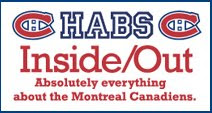





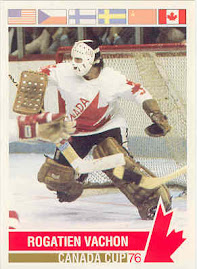
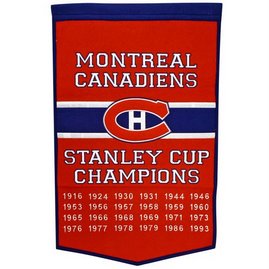







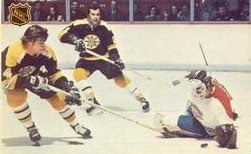



















































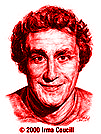



































































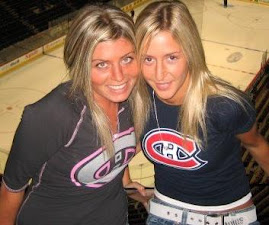


















6 comments:
Robert, this is the great thing about your blog... bu reading it I learn something new every day! I was unaware that the sweaters from that year at some point didn't contain a maple leaf as part of the logo.
About the logo being superimposed on the photos:
Two of the posed player photos in your entry show the sweater without the maple leaf background; what probably happened was that the leaf was added after the photos on the hockey cards were posed for, but before the cards were released; the photos and the cards were touched up to reflect the new look of the sweaters.
Also, the painting on the Giant Tiger store is telling, in that it also doesn't include the maple leaf. It obvoiously wouldn't have been painted from the artist's memory; a photo must exist from which the artist drew his inspiration. And if that's the case, why would he/she omit the leaf unless it wasn't in the photo that they worked from?
It might be worth a trip to the store to find out who painted the mural, and then to track down the further photographic evidence of the sweater without the leaf.
Chuck, I'm near Rockland every winter when my daughter is in Orleans playing. I'll drop by next time and investigate.
I also noticed that the sepia toned photo, and the small Didier Pitre shot do not have the leaf as well. Too bad there aren't more shots from that season to explore.
Once this series gets into the early 1920's, I have so many photo's I might just have to post them in a separate entry.
That little technicality about the ownership change in 1910 is a funny reminder of how fluid early pro hockey was. Didn't the Tecumsehs evolve or merge into the Blueshirts, the franchise that, through a similar technicality (the owner losing all his players and having an empty team in an empty league), "spawned" the Arenas, which became the St. Patricks, and then the Maple Leafs?
Dougie, that would be a hoot had it played out like that, but it's not quite how it went.
The Tecumsehs and Blueshirts were separate entities that began in the NHA in 1912-13.
The Tecumsehs became the Ontarios the following season, and then the Toronto Shamrocks midway through the 1914-15 season before going under for good.
It was the Blueshirts, who belonged to Eddie (1 team, 1 league) Livingstone.
The Arenas, St Pats, Leafs thread were a completely different franchise granted at the formation of the new NHL league in 1917.
The confusion sometimes lies in the fact that the NHL governors allowed the Arenas to initially be populated with players still under contract to Livingtone.
There is no correlation between the former Canadiens franchise, the Tecumsehs, and the reincarnated Arenas into the Maple Leafs.
However, if you are still tuned in when I get to 1938, you'll read that it was Conn Smythe that kept the Canadiens owners, the CAC, from moving the Habs to St.Louis, and keeping the Maroons in Montreal.
Juicy stuff, no?
Is there any actual reference in print to a leaf on the Habs sweater? How about the colour?
In print, possibly not. But in photo evidence over the next four seasons, a green leaf is clearly evident on Canadiens players uniforms.
I've yet to see a blue one, other than froma diseased branch, fall from a Maple tree.
Post a Comment